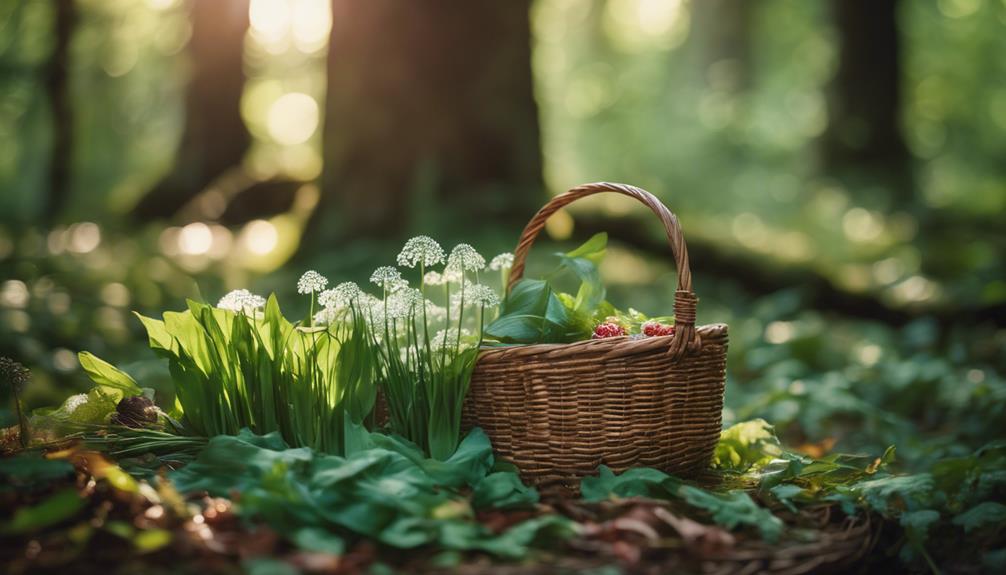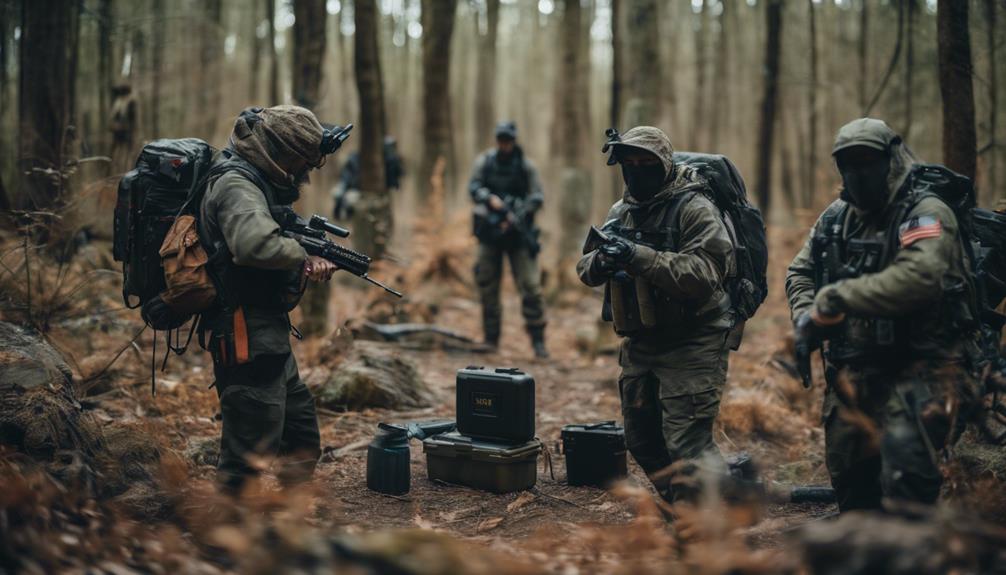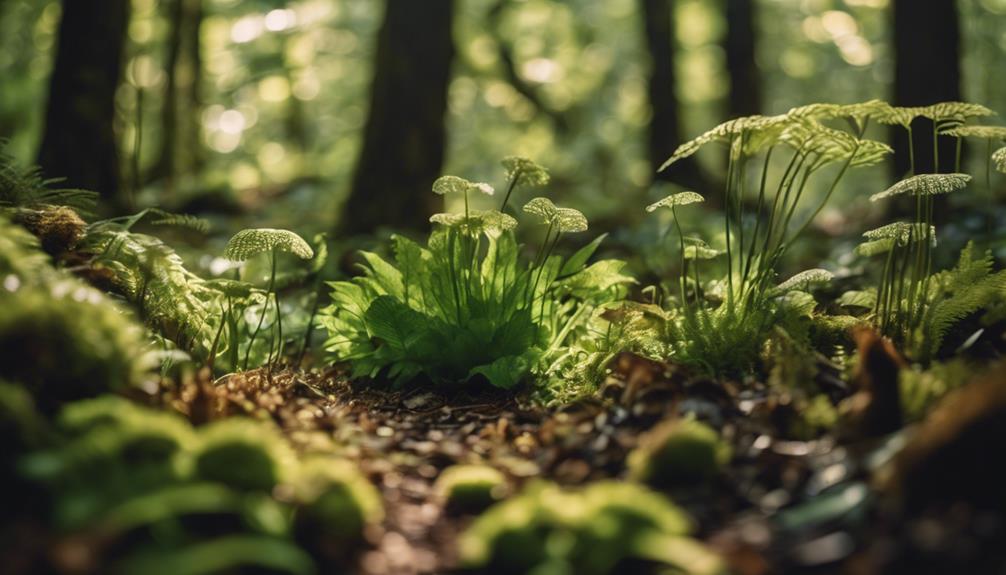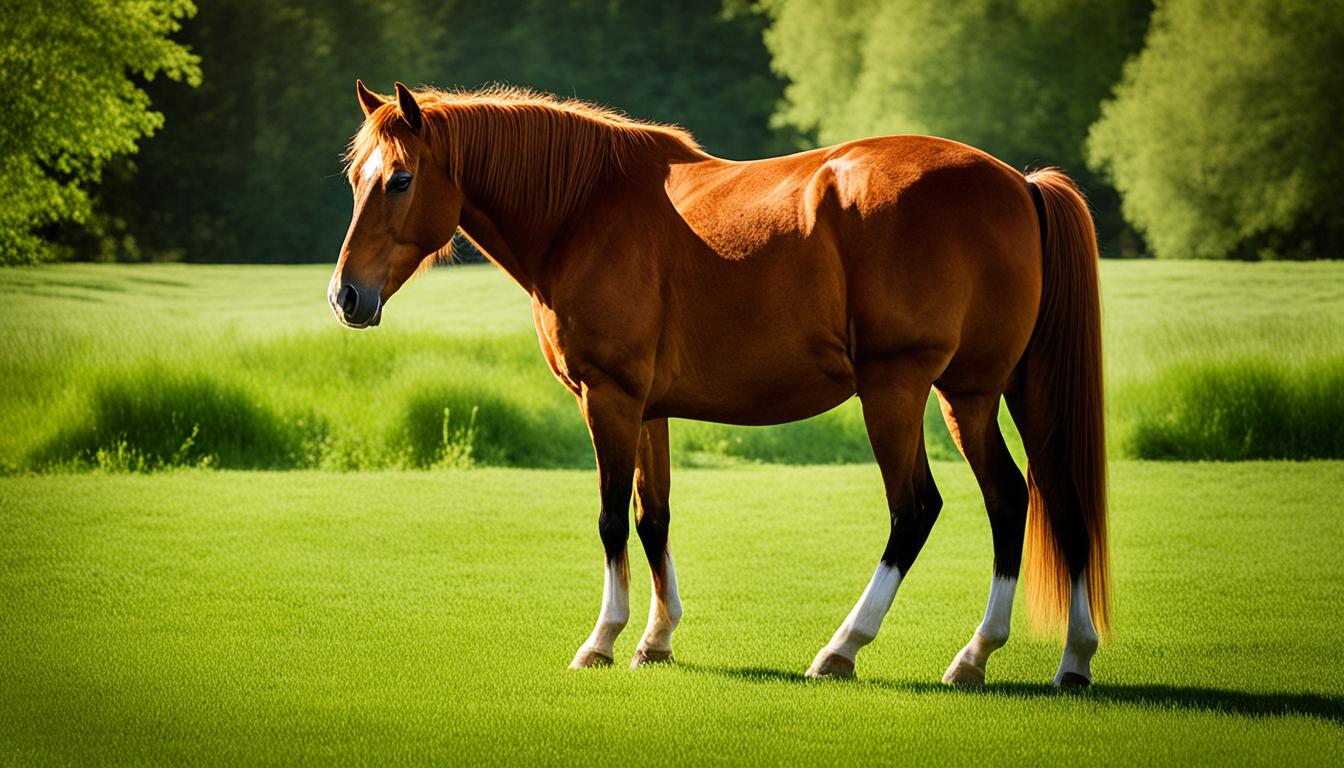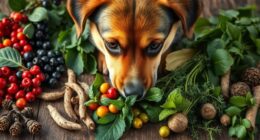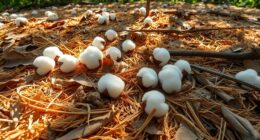You can forage for free in the UK, surrounded by an abundance of wild edibles waiting to be discovered, from fruits and flowers to fungi and foliage, in parks, campsites, and hikes. With responsible foraging, you'll safeguard natural ecosystems and wildlife habitats while enjoying the freshest, seasonal ingredients. From nettles to wild garlic, and blackberries to sweet chestnuts, you'll uncover the best edible finds across different seasons. By following essential foraging tips and guidelines, you'll guarantee a bounty of fresh, nutritious food while maintaining biodiversity and ecosystem health. As you explore the world of wild edibles, you'll uncover more secrets to elevate your culinary creations.
Key Takeaways
- Foraging in the UK is legal, but ensure you have permission to forage on private land and respect wildlife habitats.
- Identify plants correctly to avoid toxic species, and use field guides, apps, and expert guidance if needed.
- Responsible foraging practices, like leaving some for wildlife and not overharvesting, preserve ecosystems and ensure long-term availability.
- Explore woodlands, hedgerows, meadows, and coastal areas for wild edibles, and join guided tours or courses to learn more.
- Always follow sustainable foraging guidelines to minimize environmental impact and protect biodiversity.
What Is Foraging in the Uk?
What does it mean to forage in the UK, and how can you tap into this natural abundance? Foraging in the UK involves gathering wild foods like fruits, flowers, fungi, and foliage for free. You're not limited to just a few areas; wild plants grow naturally without human intervention, providing an abundance of edible options throughout different seasons.
You can find surprising opportunities for foraging wild foods and connecting with nature in parks, campsites, and hikes.
To get started, remember some essential foraging tips. Be sure to identify wild plants correctly to avoid toxic ones. Always seek permission before foraging on private land. And, forage responsibly to protect wildlife habitats. By doing so, you'll be able to enjoy the variety of wild foods while preserving nature's bounty for future generations.
Benefits of Foraging Responsibly

As you begin foraging in the UK, it's vital to adopt responsible practices that prioritize the environment, guaranteeing that the natural abundance of wild foods remains available for you and future generations to enjoy. By embracing ethical practices, you'll not only minimize your environmental impact but also contribute to the preservation of natural ecosystems and wildlife habitats.
Here are some key benefits of responsible foraging:
- Preserves natural ecosystems and wildlife habitats for future generations
- Ensures the availability of wild plants for years to come
- Shows respect for property rights by obtaining permission before foraging on private land
- Contributes to biodiversity and ecosystem health by leaving some foraged items for wildlife
- Minimizes environmental impact by following sustainable and responsible foraging guidelines
Essential Foraging Tools and Gear

As you gear up for your foraging adventures, it's crucial to have the right tools and gear to make the experience efficient and enjoyable.
You'll want to gather some must-haves, such as a sturdy basket, a reliable hand lens, and a trusty knife, which will become your go-to companions in the field.
In the following sections, we'll explore the necessities of foraging baskets, hand lenses, and knives, as well as field guides and apps that'll enhance your foraging experience.
Foraging Basket Essentials
You'll need a few essential tools to get started with foraging, and a well-stocked foraging basket is the key to a successful and enjoyable foraging experience. Investing in quality tools can make foraging easier and safer for beginners and experienced foragers alike. Here are the must-haves for your foraging basket essentials:
- Gloves: Protect your hands from thorns, prickles, and dirt while foraging.
- Basket: A sturdy, ventilated basket to collect and carry your foraged goodies.
- Pruners: For trimming and harvesting plants without damaging them.
- Magnifying Glass: To examine plants up close and identify them accurately.
- Digging Fork: For gently digging up roots and tubers without damaging them.
Having these essentials in your foraging basket will make sure you're prepared for a successful foraging trip. Remember, quality tools make a big difference in your foraging experience.
Hand Lens and Knife
With your foraging basket essentials in place, it's time to add two more critical components to your gear: a hand lens and a knife, which will help you accurately identify plants and harvest them safely.
A hand lens is a game-changer for plant identification. By magnifying tiny details, you'll be able to distinguish between similar species and make informed decisions. For instance, you can examine the shape of leaves, the color of stems, or the pattern of veins. This level of precision is essential when foraging, as misidentification can have serious consequences.
As for your knife, it's an indispensable tool for harvesting and preparing your finds. A quality knife will allow you to cut plant samples and process wild foods on the go. Whether you're trimming wild garlic or slicing mushrooms, a sharp blade will make the task much easier.
Field Guides and Apps
To guarantee accurate plant identification and enhance your foraging experience, it's essential that you arm yourself with reliable field guides and innovative apps that provide instant access to a vast wealth of botanical knowledge.
As you venture into the wild, having the right tools by your side can make all the difference. Here are some must-haves to contemplate:
- Carry a magnifying glass to examine plant details for proper identification
- Download the What Three Words app to mark exact locations of wild plants for future reference
- Invest in essential foraging tools like gloves, baskets, and pruners for safe and efficient gathering
- Always have a compact knife and kitchen scissors handy for harvesting and preparing foraged ingredients on the spot
- Utilize field guides and apps that provide detailed descriptions, images, and identification tips for various plant species
Monthly Foraging Calendar Guide

This monthly foraging calendar guide breaks down the best edible finds by season, ensuring you're always on the lookout for the freshest, most flavorful ingredients. As you venture into the UK's wild, you'll want to know what's in season to make the most of your foraging adventures.
In the early spring, you'll start to notice the first signs of new life. February is the perfect time to spot snowdrops, and if you're lucky, you might even catch a glimpse of wild garlic peeking out from under the frost.
As spring plants start to emerge, March brings an abundance of nettles, wild garlic, and dandelions, making it the best foraging time for these edible wild treats.
April showers bring May flowers, but they also bring an explosion of wild herbs and edible plants like nettles and elderflowers. By following this monthly guide, you'll be able to pinpoint the best times to forage for your favorite ingredients, ensuring your pantry is always stocked with the freshest, most flavorful goodies.
Popular Edible Wild Plants

As you start your foraging journey, you'll discover a variety of wild edible delights that can elevate your cooking. From common weeds to sweet treats, these plants aren't only free but also packed with flavor and nutrients.
Let's explore the world of wild edibles, where you'll find delicious surprises like nettles, wild garlic, and sweet chestnuts waiting to be discovered.
Wild Edible Delights
You'll find a variety of popular edible wild plants in the UK, including nettles, wild garlic, elderflowers, blackberries, and sweet chestnuts, all waiting to be foraged and added to your culinary creations. These wild edibles can elevate your cooking and provide a fresh, seasonal twist to your recipes.
Here are some tips to get you started:
- Nettles are best picked in early spring, when the young leaves are tender and packed with nutrients. Use them in soups, stews, or as a spinach substitute.
- Wild garlic thrives in wet ground from late March, adding a pungent flavor to sauces and marinades.
- Elderflowers are available from late May to early July and are commonly used in cordials and desserts.
- Blackberries are abundant in autumn and freeze well for later use in smoothies, jams, and baked goods.
- Sweet chestnuts are versatile for making pestos and roasting, adding a unique flavor to dishes.
When foraging wild, remember to identify plants correctly, avoid polluted areas, and only pick what you need to maintain sustainability. Happy foraging!
Common Weeds to Eat
Exploring, discover, guarantee, it's crucial to
Beyond the well-known wild edibles, common weeds like chickweed, sorrel, nettles, and chervil can add a burst of freshness and nutrition to your meals. As you explore foraging in the UK, it's crucial to familiarize yourself with these edible weeds. Not only do they offer a wealth of nutritional benefits, but they can also add unique flavors and textures to your dishes.
Chickweed, for instance, can be used in salads, while sorrel's tangy flavor pairs well with fish. Nettles, rich in iron and protein, can be added to soups or stews, and chervil's delicate flavor complements chicken or fish dishes. When foraging for these common weeds, remember to exercise caution and guarantee proper identification to avoid toxic lookalikes.
Safe Foraging Practices to Follow

When foraging in the UK, you must take certain precautions to guarantee a safe and sustainable experience. To secure a fun and responsible foraging adventure, follow these essential guidelines:
- Always identify plants positively before you forage to avoid picking toxic species.
- Seek permission before foraging on private land and respect local regulations.
- Forage responsibly by not overharvesting and leaving enough for wildlife.
- Carry a guidebook or join guided foraging tours to learn safe practices.
- Sustainable foraging practices help maintain biodiversity and ecosystem health.
Where to Find Wild Edibles in UK

Explore woodlands, hedgerows, meadows, and coastal areas to discover a wide variety of wild edibles thriving in their natural habitats across the UK. You can find food in these areas, including plants you can forage for a delicious and healthy meal.
Woods and hedgerows, in particular, are hotspots for wild edibles, with species like wild garlic, wild mushrooms, and hazelnuts waiting to be discovered. Foraging in these areas requires both knowledge and caution, as some plants and fungi have dangerous look-alikes. However, with the best wood foraging tips at your disposal, you can confidently identify the edible treasures nature has to offer. Always be sure to forage sustainably, taking only what you need and leaving enough for wildlife and continued growth. Foraging wood safely is just as important as identifying edible plants, as certain types of wood can be harmful if used improperly for food preparation or fires. Always gather wood from clean, unpolluted areas and steer clear of any treated or decaying wood that may harbor toxins or harmful fungi. By respecting nature and practicing sustainable foraging, you’ll help maintain the balance of these ecosystems for future generations.
Beyond these natural habitats, you can also find wild edibles in urban areas with abundant green spaces, parks, and public footpaths. Joining foraging courses or groups can provide valuable guidance on where to find wild edibles and how to identify them safely.
Local foraging experts and organizations offer insights into prime foraging locations based on the season and regional flora, helping you find the best spots to forage. Remember to always secure landowner permission, respect wildlife habitats, and follow local regulations to maintain sustainable foraging practices.
Common Foraging Mistakes to Avoid

As you venture out to forage, beware of common mistakes that can land you in trouble, harm the environment, or even put your health at risk. When it comes to foraging, being mindful of potential pitfalls to avoid is crucial.
Here are some common mistakes to watch out for:
- Misidentifying plants: Make sure you can identify any plant you plan to eat, as some can be toxic or even deadly.
- Overharvesting: Avoid over-picking, as this can harm local plant populations and ecosystems.
- Foraging on private land: Always get permission before foraging on private land to avoid trespassing and potential legal issues.
- Disrupting the food chain: Be mindful of leaving enough wild foods for wildlife, as over-foraging can disrupt the natural food chain.
- Foraging protected species: Be aware of protected species and avoid foraging them, as this can have legal consequences and harm conservation efforts.
Delicious Recipes for Foraged Foods

Now that you've mastered the art of responsible foraging, it's time to get creative in the kitchen with your wild finds, experimenting with unique flavors and ingredients to elevate your everyday meals.
With the diversity of edible plants and herbs available in the UK, the possibilities are endless. Try combining sea beet with duck egg and new potatoes for a savory twist on a classic dish. Or, indulge in the sweetness of bilberries by whipping up a bilberry and almond streusel cake.
Foraging in the UK offers a wide range of seasonal produce to incorporate into your recipes, from wild garlic to elderflower. Experiment with different cooking techniques to bring out the best flavors in your foraged ingredients.
Get inspired by the wild and let your culinary creativity shine! With a little practice and patience, you'll be whipping up delicious recipes that showcase the best of the UK's foraged foods. So, don't be afraid to get creative and enjoy the fruits of your labor – literally!
Frequently Asked Questions
Is It Illegal to Dig up Wild Plants in the Uk?
You'll need permission to dig up wild plants in the UK, as it's illegal without landowner consent, thanks to laws protecting wildlife and habitats – violating them can lead to fines and environmental damage.
Is It Illegal to Pick Wild Garlic in the Uk?
"As you venture into the wild, the aroma of garlic whispers secrets in your ear. Rest assured, picking wild garlic in the UK is legal on public land for personal use, but get permission for private land, okay?"
What Is the Best Month to Go Foraging?
You'll find the best foraging month depends on what you're after: spring for wild garlic and nettles, summer for berries and mushrooms, autumn for nuts, and winter for winter fruits and fungi.
Is It Legal to Forage in the Us?
You're not stuck in a sea of uncertainty! In the US, foraging laws vary wildly, but generally, you're allowed to forage on public lands, like national parks, and private lands with permission, but always check local regulations to avoid trouble!
Conclusion
As you venture into the world of foraging, remember to always prioritize purity, precision, and patience.
Practice prudent picking, avoiding polluted patches and pesky pests.
Pursue sustainable practices to preserve the planet's precious produce.
Happy foraging!

